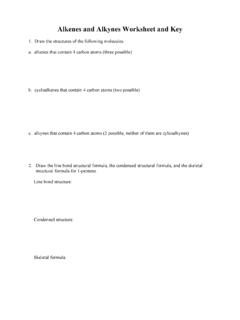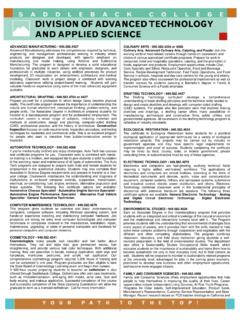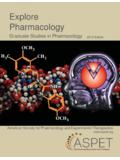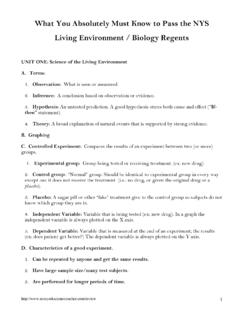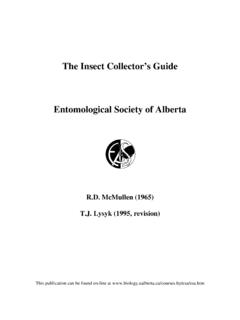Transcription of Biology 20 Laboratory Animal Reproduction
1 1 Biology 20 Laboratory Animal Reproduction OBJECTIVE To study the various types of Reproduction . To differentiate between asexual and sexual Reproduction . To observe sperm, ova and the fertilization process of sea urchins. To study early embryonic development of sea urchins. To study the human reproductive system. INTRODUCTION Reproduction is the process by which new individuals of the same species are produced from pre-existing ones, resulting in an increase in the number of individuals. As you may recall, not all organisms have an equal opportunity to reproduce. Individuals within a species with phenotypes that are better suited for the given set of environmental conditions will reproduce more than those that are not as suited (differential Reproduction ). Thus, Reproduction is a means of passing on genetic information from generation to generation. In this week s lab we will examine two types of Animal Reproduction : asexual and sexual.
2 Animals can reproduce exclusively by asexual or sexual, or alternate between them. A. ASEXUAL Reproduction Organisms that reproduce asexually (a mitotic process) are often found in environments that have stable conditions. Individuals with the favorable phenotypes for that environment perpetuate the successful genotype by producing offspring genetically identical to itself (essentially a clone) in a short amount of time. There are three different types of asexual Reproduction . Fission involves the separation of a parent into two or more individuals of the same size. All prokaryotes and some protozoans utilize this strategy. Budding occurs when a new individual grows out from the body of an existing one as a result of unequal division of the organism. The offspring either detaches or remains joined to form extensive colonies. Examples include freshwater hydra, corals and tunicates.
3 Fragmentation is the breaking of the body into several pieces, each of which develops into a complete adult. This must be accompanied by regeneration (the regrowth of lost body parts). Examples include sponges, cnidarians, polychaete worms and tunicates. Sea stars can regenerate lost arms via mitosis (asexual), but that is not considered a form of Reproduction to increase the population. However, if a sea star is cut in half, it can regenerate into two identical individuals because integral components are present. Organisms that cannot seek out mates (those that are sessile) or are active animals that have difficulty finding mates (such as when population density is low) will benefit from asexual Reproduction . The disadvantage of asexual Reproduction is the production of a genetically uniform population with little or no variation (diversity). If conditions change and become unfavorable, many in the population may die out.
4 Materials: Microscope, slide of Hydra budding, slide of prokaryote (non- Animal ) fission 2 Procedure: 1. Look at the prepared microscope slides of the Hydra and a prokaryote, draw what you see in each and answer the questions on your worksheet. Note: A prokaryote will be use to demonstrate fission due to time constraints. B. SEXUAL Reproduction Sexual Reproduction involves the production of offspring by the fusion of haploid gametes (sperm and ovum). Gametes are produced via meiosis. The fusion of the sperm and ovum (fertilization) results in the formation of a single diploid zygote. Sexual Reproduction involves two individuals, each contributing genetic information to the offspring. There are several types of reproductive strategies employed by animals. Parthenogenesis is a form of Reproduction in which the ovum develops into a new individual without fertilization. Offspring produced are usually haploid.
5 Certain species of bees, wasps and ants utilize this strategy for social organization. Male drones are produced via parthenogenesis whereas sterile females and reproductive queens are produced from fertilized eggs. Among vertebrates, several species of fish, amphibians and lizards also reproduce by parthenogenesis. There are 115 species of whiptail lizards (Cnemidophorus) that reproduce exclusively by parthenogenesis. There are no males, but female undergo mock copulatory behaviors depending on hormone levels. After meiosis, the ovum doubles the chromosome number and becomes diploid again. Hermaphroditism is when an organism has both functional male and female reproductive systems, like the Greek goddess Aphrodite. Organisms that utilize this reproductive strategy often times cannot find members of the opposite sex, are sessile, burrowers, or are endoparasites. In most cases, individuals must fertilize another; however, some can fertilize themselves.
6 Examples include barnacles (sessile), earthworms (burrower) and tapeworms (parasite). Sequential hermaphroditism occurs when an individual reverses its sex during its lifetime. There are two types of sequential hermaphrodites. When individuals start out life as a female and change sex to male, this is called protogynous. A classic example is the wrasse (reef fish). If there is no male present, usually the largest, oldest female changes and becomes the dominant male and will begin to produce sperm within a week. When individuals start out life as a male and change to female, this is called protandrous. An example of a protandrous species is oysters. All oysters start out life as males due to their small size. As the oyster grows and attains a certain size, it will change into a female and produce eggs. Materials: Microscope, depression slide, cover slip, sea urchin ova and sperm, whiptail lizard, Procedure: 1.
7 Obtain a depression slide and cover slip. 2. Place a drop of the fluid that contains the sperm on the depression slide and cover. 3. Obtain another depression slide and place a drop of the fluid that contains the ova (unfertilized eggs). 4. Draw what you see in each and answer the questions on your worksheet. 3C. SEA URCHIN FERTILIZATION & DEVELOPMENT In today s lab, you will examine the embryonic development of an invertebrate, the sea urchin (Phylum Enchinodermata), from fertilization through several embryonic stages. The embryos of sea urchins are often used for embryological studies because they clearly show the basic stages in the early development of many types of animals, including mammals. Fertilization is the union of the sperm and ovum nuclei (syngamy) to form the diploid zygote. There are two types of fertilization, internal or external. With external fertilization, eggs are shed by the female and fertilized by the male outside of the body.
8 The release of gametes into the water occurs without any physical contact. Sea urchins are a typical organism that utilizes external fertilization. They are broadcast spawners that release lots of gametes into the water in the hopes that the gametes will become fertilized and develop before they are eaten. The release of gametes into the water occurs without any physical contact. Some vertebrate also utilize external fertilization, but may have courtship behaviors before gamete release (fish and amphibians). With internal fertilization, sperm are deposited in or near the female reproductive tract and fertilization occurs within the female's body. Organisms that utilize internal fertilization typically have more sophisticate reproductive systems. These organisms may have copulatory organs for sperm delivery and receptacles for sperm storage and transport. Many have specific reproductive signals and cooperative mating behaviors before copulation can occur.
9 Upon fertilization, the zygote is still undivided with its nucleus still intact. Just external to the plasma membrane of the zygote is the fertilization membrane which prevents the entry of other sperm. The fertilization membrane is formed when the nucleus of the sperm and ovum fuse (syngamy). The first cell division or cleavage take place within 50 70 minutes. The embryonic cells resulting from the division of the zygote are called blastomeres. The second mitotic cleavage occurs in about two hours creating four cells. The third mitotic cleavage results in the eight cell stage. After the fourth cleavage, there is a solid ball of 16 cells called the morula (because it resembles a mulberry). The embryo is in the blastula stage when there are 32 to 64 cells. A fluid filled, hollow space in the middle of the embryo will begin to develop during the blastula stage is called the blastocoel.
10 Soon the cells will become arranged in a single epithelial layer around the blastocoel. The blastula stage will begin to undergo suite of cellular changes into a double-layered gastrula. Gastrulation begins with the invagination of cells at the bottom (or the vegetal pole) into the blastocoel. This produces a tube of cells growing upward called the archenteron (primitive gut). The opening of the archenteron is called the blastopore and will develop into the anus of this Animal first. In other types of animals the blastopore may develop into the mouth first. With the development of the archenteron, the developing embryo now has two layers of cells. These are two of the three embryonic germ layers that will ultimately give rise to all of the body parts of the adult. The ectoderm is the outer layer, formed from the original blastula wall and gives rise to the skin and its derivatives (hair and nails) and the nervous system.




